Kristen highlights how the evolution of mono White deckbuilding in Commander can teach us how the format has changed, and what’s now most important to consider.
Things are finally starting to turn around for White in EDH, and it’s been a pleasure to see some of the great new cards printed over the last eighteen months or so make it into my decks. Since around this time last year, I’ve been on a bit of an upgrade spree on my Lyra Dawnbringer Commander deck, and there hasn’t been a moment when I’ve not been testing new cards and trying to make reasonable cuts, whilst still keeping the overall feel of the deck.
Lyra Dawnbringer
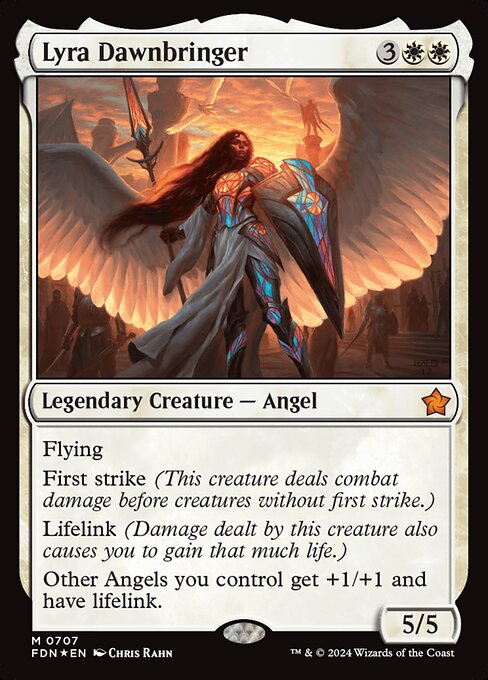
If you’ve read my column previously, you’ll know that I like to play at the 6-7 level primarily, with games that last at least eight turns, with everyone able to ‘do the thing’; getting to see their decks function, at the very least. My Lyra deck is primarily an Angel tribal deck, but with some ancillary synergies. I’ve spoken about it before, but in short; it likes to gain life, make tokens, and reanimate creatures as often as possible to help assuage the inherent card disadvantage issues in White.
Despite being a not particularly strong tribal card—giving +1/+1 and lifelink being at the lower end of payoffs, and an absence of cost reduction for an expensive tribe—Lyra and her ninety-nine have managed to hold their own through efficient plays and having a strong gameplan. And sure, sometimes sticking an Avacyn, Angel of Hope doesn’t hurt.
Of course, the game has changed over the past year, and one of the biggest disadvantages to running a Commander like Lyra is that she isn’t exactly a “Type 3” Commander. Type 3 Commanders essentially have a signposted theme, plus an enabler and/or a payoff on one card; think Arcades, the Strategist, Korvold, Fae-Cursed King, Golos, Tireless Pilgrim, or Chulane, Teller of Tales. Nowadays, Commanders that don’t do everything in one card find it harder and harder to compete, especially when these cards are more and more present at casual tables.
It used to be that Lyra could tussle with tables featuring one or two of these decks and win a war of attrition, but the game has changed in such a way that that particular strategem is rarely on the cards unless things really line up. I’ve played countless games in recent times where just hitting land drops and playing spells doesn’t impact the game against these kinds of decks. So, what’s changed?
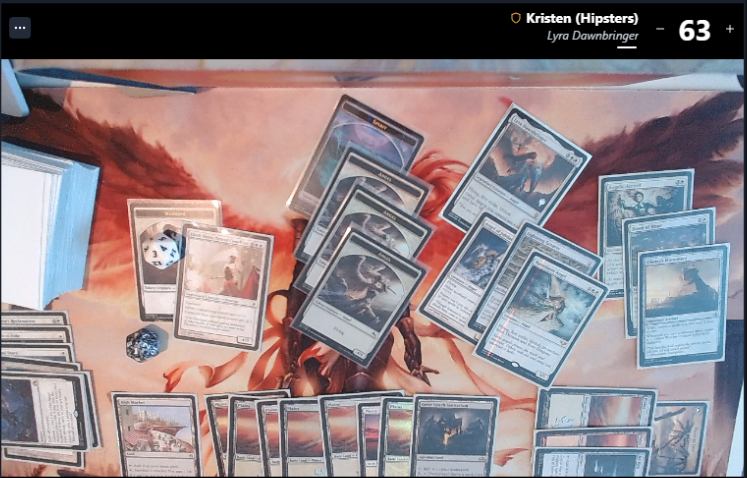
A late game win vs Alesha, Tymna/Ikra Shidiqi & Yuriko, played on SpellTable.
EDH is now Online
I think the first thing we need to address, the elephant in the room, if you will, is that EDH is now online. Yes, it technically has always been online, with the ability to play on MTGO, and the wealth of information from content creators and sites like EDHRec contributing to a steady stream of relevant ideas. Now, though, we’re playing online almost exclusively thanks to the pandemic. It’s my opinion that the centralization of the format to online spaces has accelerated the power creep of the format, more so than solely the printing of more powerful cards, and the natural dissemination of information ever could.
Outside of regular playgroups—playgroups that might be more “chill”—the competitiveness of games has increased. Thanks to the Generous Gift of SpellTable, a fantastic application to play paper EDH on, players previously unable to get their fix can drop in on a game. The drop in nature of playing with strangers (or relative strangers, at the least) has overall meant people are shooting a little high on power level. Now, this is ordinarily not an issue, as in a fixed playgroup, it’s not out of the ordinary for the preliminary games to be a little mismatched while the group finds their power level. After that, things tend to balance out.
In online spaces, however, playgroups persist between sessions less often, and so the “preliminary” level-setting accounts for far more games. When you factor in the anonymity factor of playing with strangers, and the often anonymous matchmaking on different discord servers, you start to increase power levels too; a lot of people do just want to win, and so they’ll overshoot rather than undershoot. This all comes together into the perfect storm: if people’s experience is that more of their opponents have higher estimations of what constitutes a mid-power deck, then whether their opinion on that matter changes or not, they’ll either have to pick a different deck, or power up their existing ones.
However nebulous the scales and systems are, it results in a general truism: the sevens of yesterday are the eights of today.

Refurbish by Johann Bodin.
Time to Refurbish
Unfortunately, for mono White decks like Lyra, this means that they slip further behind unless they adapt. It’s been an interesting process, adjusting Lyra to keep up, and upon reflection, has offered some interesting data points to consider in regards to how the format has changed of late.
The first thing I think many can agree on is that games are quicker, overall, than a year or two ago. This is outside of combo decks, too; decks tend to hit terminal velocity a turn or two sooner. This is in part due to the power creep of cards, but also in how cards are now designed more for Commander. This results in decks that are more synergistic, with more redundancy—you only have to look at Green-based decks to see this in its most obvious form. Getting Guardian Project, Beast Whisperer, The Great Henge and Garruk’s Uprising in quick succession, and watching them become staples just as quick, has really changed how much draw power Green gets. With more draw comes quicker access to win conditions.
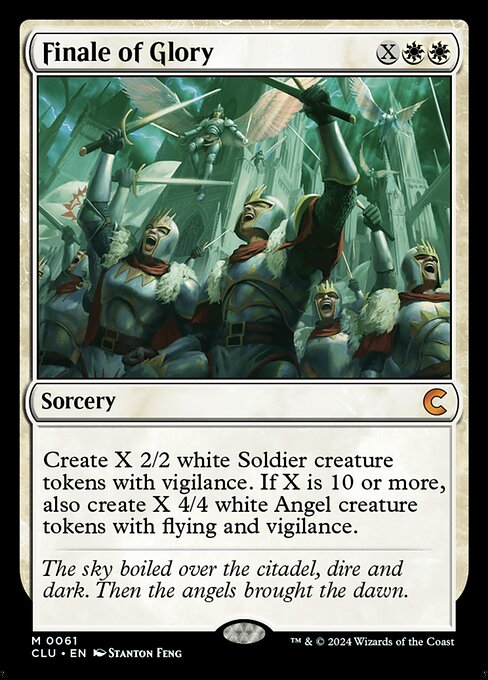
I used to play Lyra without a Sol Ring, as I believed it limited the slots I could use on more fun and unique cards. I still believe that that’s true, but I’ve since added Sol Ring back into the deck to help the deck keep up, and occasionally, have a nice explosive start. Along the same axis, I’ve removed Finale of Glory and Mind’s Eye, which I think are just too slow for the deck to consider these days. I’ll make it clear now that I’m not advocating for powering up the deck to be more competitive—in which case I’d switch Commanders to say, Heliod, Sun-Crowned, and play much more “good stuff”—but tweaking it to keep up with decks in the 6-7 range.
In my games at this level, I’ve also found recursion to be less relevant unless it’s super efficient. In games a couple of years ago, it was correct to be playing cards like Auramancer to grab back important targets, and for a while I even ran a copy of Refurbish in the deck to get back Platinum Angel and Aetherflux Reservoir. While these effects can seem a little reactive, the approach I have to recursion in White and Boros is more proactive, utilizing the discard on cards like Geier Reach Sanitarium and Mask of Memory. Now that the grindier games at this level occur less often, it takes up too many card slots to overly stack the deck with recursion—especially when it’s not led by a commander that cares about it.
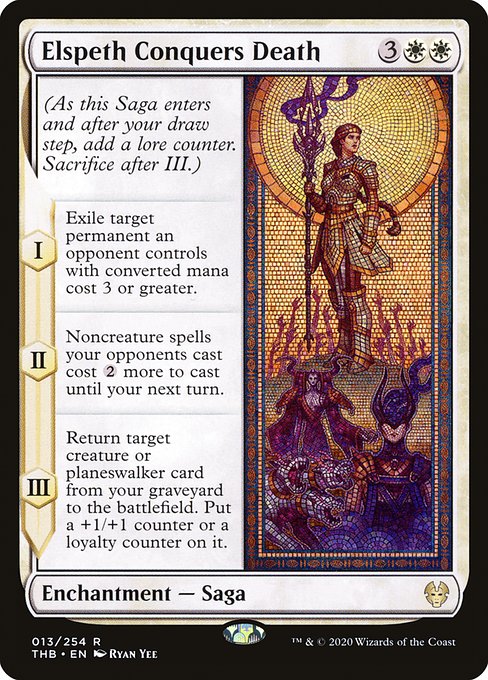
As such, I’ve replaced those cards with Elspeth Conquers Death and Sevinne’s Reclamation. Elspeth Conquers Death gives the deck an additional piece of flexible removal that can answer most problems, and, If it comes down ahead of curve or after a board wipe, a deceptively disruptive second mode. The final mode leans into our proactive recursion; even if we just sacrifice a Solemn Simulacrum with our High Market in our Upkeep, we’ll be getting some value. Flexibility is key in Commander, afterall, and this card can perform in many scenarios.
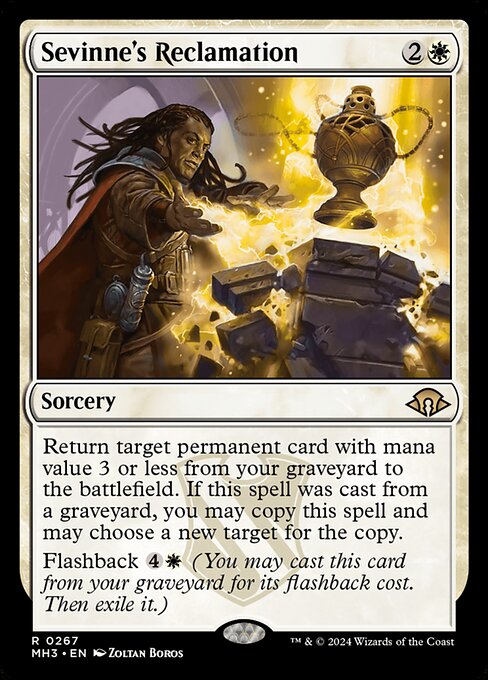
Sevinne’s Reclamation feels like a strict upgrade to Auramancer, especially as we don’t solely care about enchantments. In many ways, Auramancer was a relic of the times I used to run cards like Authority of the Consuls in the deck, but Sevinne’s just does so much more. Whether it’s flashing back from the yard to bring back Sword of Fire and Ice and Soul Snare, or just paying three to get a land out of our bin, it’s always a great card. The value of being able to recur more expensive cards with Auramancer is less relevant when games are over quicker, and the tempo loss suffered from having to recast whatever we recur is more damning.
The decks we face are stronger and more consistent, and because a rising tide raises all ships, we do need to be conscious about how exactly we adapt to that situation. Despite being on the sidelines previously for being not very on theme, the deck now includes Elesh Norn, Grand Cenobite. The Anthem and mini-board wipe is a great way to close games, and honestly, I feel like the deck needs it nowadays to go toe to toe. It’s a very strong card.
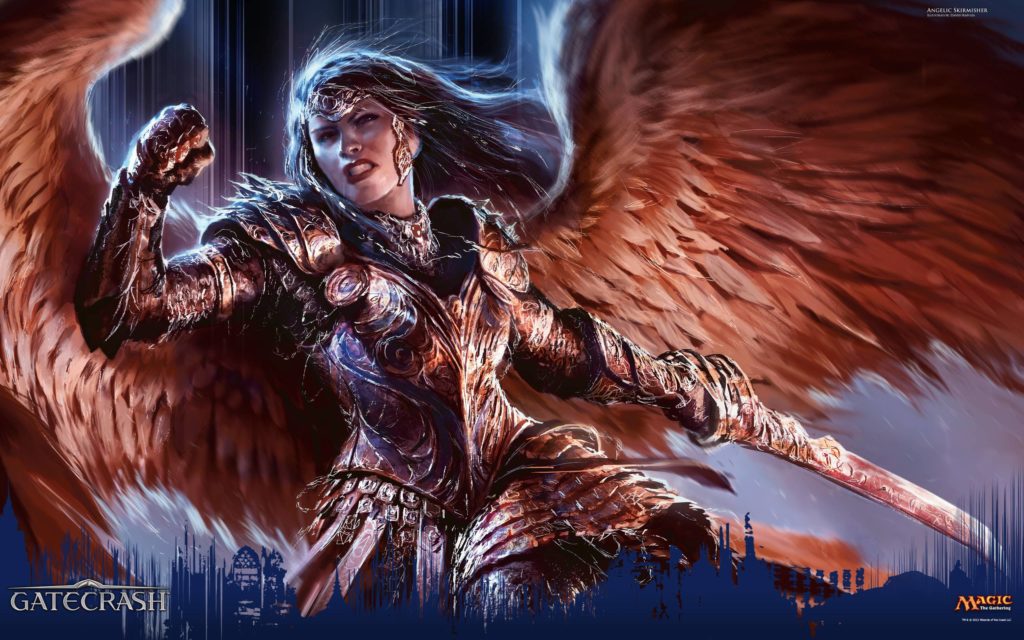
Angelic Skirmisher by David Rapoza
Maximizing Efficiency
Next up, let’s look at some slightly more controversial changes, and my methodology behind them. I’ve recently dropped Return to Dust and Crush Contraband from my deck, and replaced them with Heliod’s Intervention and Dismantling Wave. Now, hear me out.
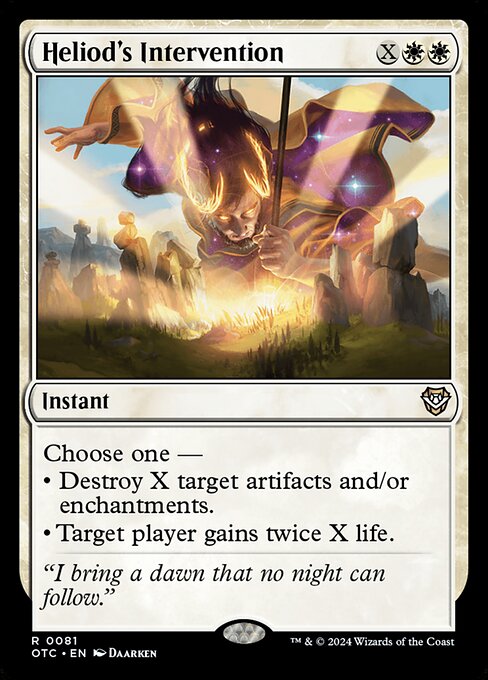
Due to the faster pace of games these days, the advantage gained from exiling permanents at the cost of efficiency is now a very real debate, especially with the prevalance of cheap, flexible graveyard hate, and the collective desire of the rest of the table to keep on top of graveyards. Playing Return to Dust was always frustrating because in many ways it’s a sorcery speed card. Crush Contraband, while easier to cast, has less flexibility; you’re unable to choose two artifacts, or two enchantments.
Exiling is always the preferred option, and in decks capable of it, like White/Black decks, there’s no reason not to just default to cards like Anguished Unmaking and Utter End. For mono White, however, I think there’s a factor which muddies the water somewhat: tempo. In White decks, your ability to hit multiple spell turns, and generate card advantage by not just using one-for-one removal has never been more important. As such, using Return to Dust during your mainphase, or hitting only one target on Crush Contraband, can be pretty underwhelming. Board wipes alone aren’t enough, and a good percentage of the time, dropping a board wipe as an answer is unattractive. You’ll take a turn to reset things, watch the non White players bounce back, then take a turn to play one large creature or effect, and have very few cards left in hand, if at all.

Dismantling Wave helps fix this issue. At three mana, it’s more akin to Plaguecrafter than Grasp of Fate, and I don’t have to tell you which of these cards sees more play. It can be played on curve, and can really do a number on decks trying to set up, especially those that have kept greedy hands that rely on setting up value engines. It also has the second mode of being an un-counterable board wipe that draws a card later in the game, which is sweet.
Heliod’s Intervention, meanwhile, offers selective pruning without sacrificing your own permanents to a similarly costed board wipe, plus the ability to act as a semi-Fog, or trigger your lifegain synergies, thanks to the second mode. The need to move away from one-dimensional spells has become enough of a priority for me to cut some of my pet angels, Angelic Skirmisher and Indomitable Archangel. In a vacuum, they just don’t do enough, and are unimpressive curve toppers that don’t offer enough value. In a world of Uros and Questing Beasts, they’re mediocre at best.
They were easy cuts for Mangara, the Diplomat and Verge Rangers, who ramp up our overall consistency with powerful card draw and card advantage. I don’t think I need to explain how good these cards are; you should be running them.
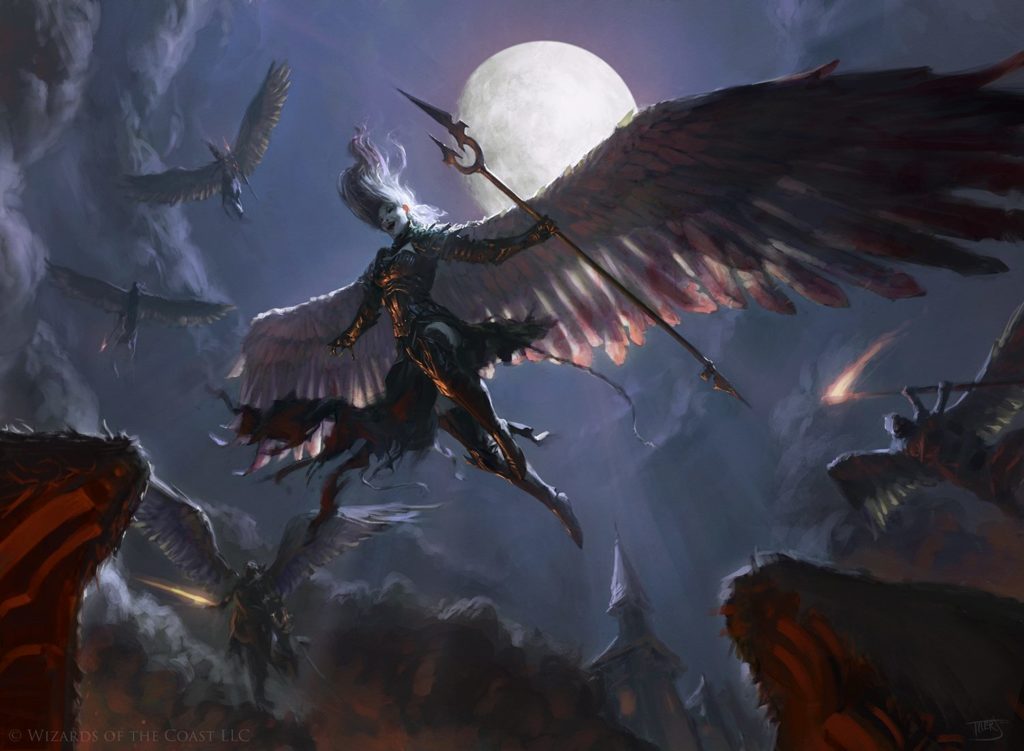
Descend upon the Sinful by Tyler Jacobson
Overperformers
There are a number of other cards that I’ve found are over-performing these days, and I think looking at exactly why can offer even more insight into how the format is shaping up.
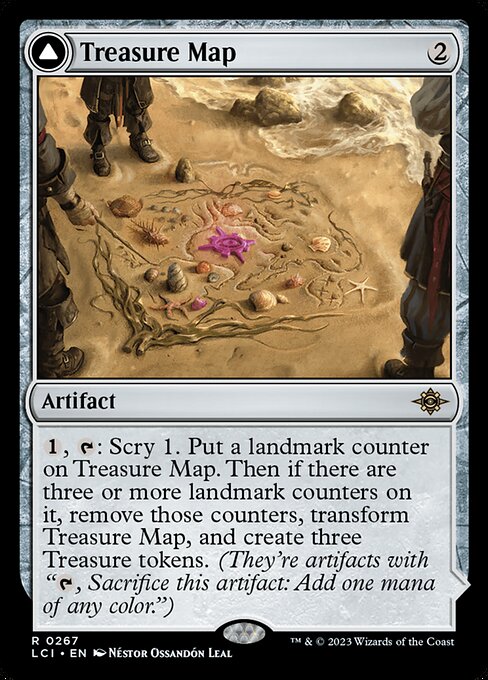
Treasure Map is a fantastic piece of technology for White decks. The ability to fix draws in the early game, ensuring land drops can be hit (or putting excess land to the bottom) is very good for a faster metagame; and when it flips, having a burst of mana to hit two spell turns is much appreciated. The ability to use the treasures to dig deeper is also great, and combines with Smothering Tithe very well.
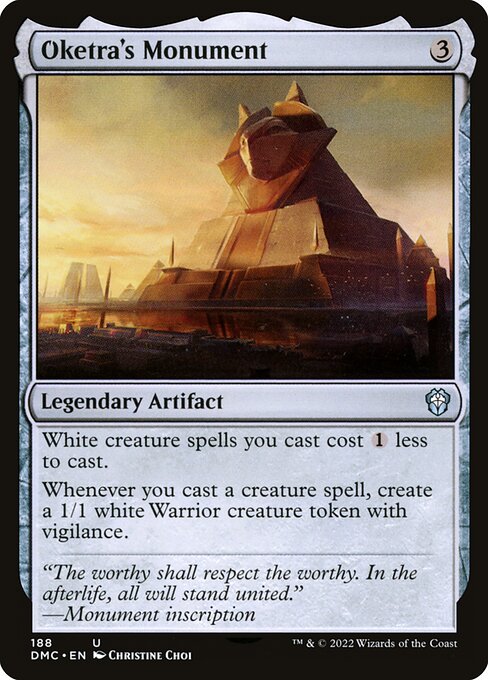
While I’ll always treasure cards like Burnished Hart that extract lands from the library, I think cost-reduction cards have increased in power lately as we try and hit two-spell turns as quick as possible. Much like Pearl Medallion, Oketra’s Monument can help us cast our more expensive spells, but offers something more—chump blockers that can be cashed in with Skullclamp for cards. They’re also great with High Market for enabling Dawn of Hope.
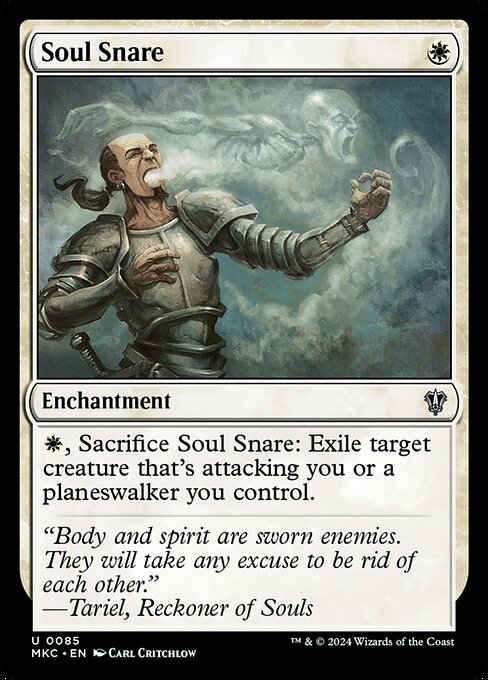
Soul Snare is fantastic. It’s cheap, efficient, and easily recurrable. It’s also a great rattlesnake in times where creatures are more and more pushed, and attack or damage triggers are a big part of many decks. Along the same axis, I’ve found both Descend upon the Sinful and Angel of the Dire Hour to be of higher importance than usual, as creature-based engines are often the problem these days. Holding up the Angel is a lot easier now thanks to more cards that can be held up for higher costs in White.
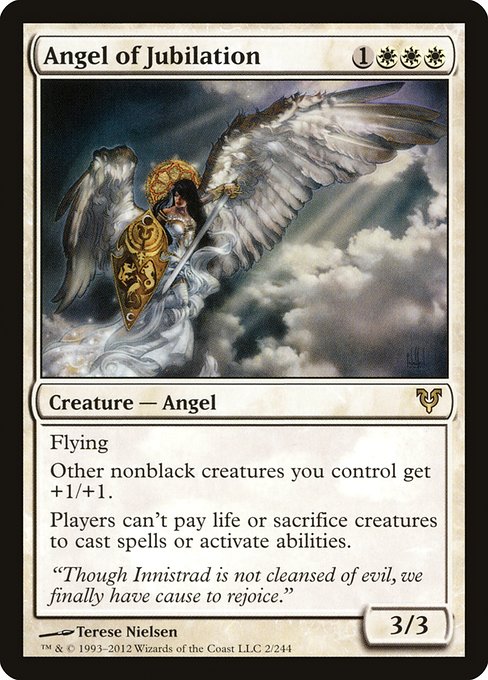
Sacrificing and paying life are at the heart of most shenanigans these days, and this angel is increasingly important to slowing the game down to our speed. I recently wrote that hate bears are back in vogue, and between Angel of Jubilation and Linvala, Keeper of Silence, I feel pretty good about slowing my opponents.
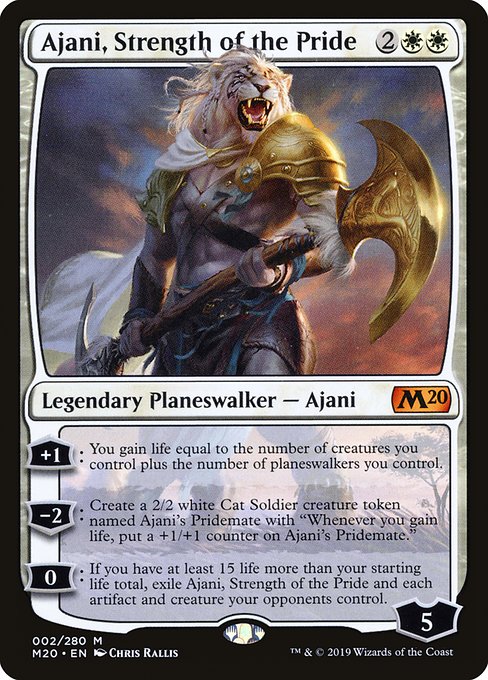
Hitting 55 life isn’t difficult for this deck, and the reward for doing so is a sweet, sweet one sided boardwipe. Lifegain has become more and more relevant at casual tables, and the amount of games I’ve won thanks to keeping a little ahead of the pack is notable. Bishop of Wings is another great lifegain enabler for our token engines Angelic Accord and Respendent Angel. Between these and Heliod’s Intervention, we should have no trouble firing off Aetherflux Reservoir to bring on the end game. Being able to have an alternate win condition has never been more important, and the ability to “double tap” by hitting one opponent and gaining a chunk of life before lasering another, is not to be understated.
In Closing
The ways in which I’ve changed my approach to both deckbuilding and gameplay when it comes to mono White, to me, seems reflective of the format as a whole. Games are quicker, maximizing efficient plays is more important, and staying alive until the late game requires more resources and more clever sequencing. Smaller value pieces often stick around longer, so re-using relevant EtB effects with cards like Angelic Renewal is also attractive, and selectively pruning while advancing your own board is the only real way forward. That said, the pruning should still aim to be efficient, and so Volcanic Offering and the like are always more impactful than a single-target spell. I’ve even cut a land, as I’d much rather the games that my deck does perform don’t end in flooding, as opposed to just lowering the amount of complete misfires.
It might seem unintuitive, but the power creep and changes to Commander gameplay have pervaded even at levels below fully optimised decks. This will continue as time goes on. Playing in Online communities has accelerated these changes in the same way that constructed formats are solved quicker online, and as always, having a healthy Turn Zero discussion is paraamount for the table to have a good experience. Don’t be afraid to talk about how efficient and powerful engines contribute to power level as much as combos and tutors, but don’t be afraid either to play a game or two to feel out your playgroup. It’ll be better after that.
As always, let me know your thoughts on Twitter.
Based in the UK, Kristen is a lover of both Limited and Commander, and can most often be found championing the Boros Legion when called upon to sit down and shuffle up.

